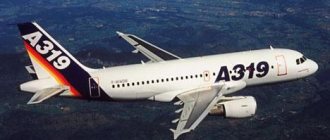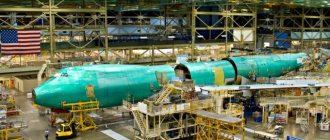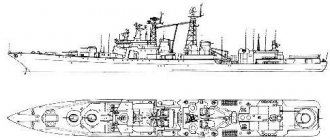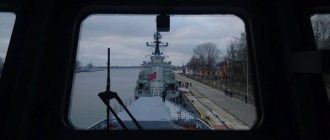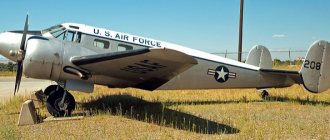G. Baidukov, V. Chkalov and A. Belyakov. Photo: TsGAMO
83 years ago, Soviet pilots Valery Chkalov, Georgy Baidukov and Alexander Belyakov took off from the Shchelkovo airfield near Moscow on an ANT-25 aircraft, heading for the North Pole. After 63 hours, having covered 9,130 kilometers in the air without landing, they landed in Vancouver, America. The flight took place in extreme conditions, but, despite the difficulties, Chkalov and his crew completed the task. Flight on the record ANT-25 aircraft created by A.N. Tupolev and P.O. Sukhim, opened an air route through the North Pole and strengthened relationships between countries.
A plane designed to win
First, it’s worth talking about the ANT-25 aircraft itself, without which the legendary flight could not have taken place. This unique machine owes its appearance largely to the great interest of I.V. Stalin on the topic of aviation records. He personally turned to aircraft designer A.N. Tupolev to create an aircraft that could break the world record for flight range. The design of an aircraft with a maximum range of 13 thousand km was ready in July 1932. Its development at TsAGI was carried out by a team led by P.O. Sukhoi. The second name of the model is RD (range record).
This was the first time such a machine had been created. In addition to design and technical issues, new problems had to be solved, for example, how to ensure crew comfort during a long flight. Psychophysiologists were involved in calculating the cabin lighting. The developers were advised by experienced pilot M.M. Gromov, who would later test the ANT-25 and set the first records on it. Everything in this car was subordinated to one task: to set a distance record.
The ANT-25 aircraft, on which the crew of Valery Chkalov carried out the Moscow-America flight
The aircraft was designed as a monoplane with a duralumin corrugated wing of unusual extension for that time. The size of the wing allowed it to accommodate additional fuel - more than 7 tons. The ANT-25 was simple, stable, behaved well at altitude, but due to its large wingspan it had peculiarities in handling. The main difficulty was the difficult and dangerous takeoff, for which a special runway with a slide was equipped. According to Gromov, the cost of the strip exceeded the cost of the plane itself.
Two cars were created, but both did not reach the record levels. The situation was saved by improvements: an M-34R engine with a gearbox, created at plant No. 24 named after. M.V. Frunze (today – the Salyut Production Complex of UEC JSC as part of Rostec), a special carburetor, surfaces were polished, and most importantly - on the recommendation of the outstanding aerodynamicist M.A. The Thai wing of the ANT-25 was covered with canvas, which immediately added 1000 km to the range.
Ready for records
In the fall of 1934, two attempts were made on the ANT-25 to set a new world record for flight range along a closed curve, flying along the Moscow-Tula-Ryazan triangle. Twice the crew saved the car in almost hopeless situations. It should be noted that the previous record holders - the French and Italians - flew in much more favorable climatic conditions than Soviet pilots.
The third attempt to loop the route was also unsuccessful - due to the weather, the plane had to land not in Moscow, but in Kharkov. But it turned out that during the flight a world record for straight flight distance was set. The crew spent 72 hours in the air, flying 12,411 km. Unfortunately, this achievement was not formalized, since the USSR at that time was not a member of the International Aeronautical Federation.
The crew of Georgy Baidukov, Valery Chkalov and Alexander Belyakov after landing on Udd Island in the Sea of Okhotsk
After all the tests and modifications in the winter of 1934–35, the two ANT-25 aircraft were completely ready to officially set a new world record for flight range without landing. This achievement was considered the most honorable in the aviation community. Flights to South America and Australia were considered, but for political purposes the route through the North Pole to the USA was chosen, despite the fact that technically it was the most difficult. In August 1935, the crew of pilot S.A. Levanevsky took off on the route Moscow - North Pole - San Francisco, but due to an oil overflow while preparing the plane for flight, it had to be aborted after 2000 km of travel.
To test the ANT-25 again before the next attempt to fly over the North Pole, in July 1936, the crew under the command of V.P. Chkalova makes a successful 9,374 km non-stop flight to the Far East along the northern borders of the USSR. For this purpose, the Arctic model ANT-25 was modified with a system for protecting mechanisms from icing.
Mk-1 (ANT-22) characteristics:
| Modification | MK-1 |
| Wingspan, m | 51.60 |
| Length, m | 24.10 |
| Height, m | 6.36 |
| Wing area, m2 | 304.5 |
| Weight, kg | |
| empty plane | 22340 |
| normal takeoff | 33560 |
| engine's type | 6 PD M-34R |
| Power, hp | 6 x 830 |
| Maximum speed, km/h | |
| near the ground | 205 |
| on high | 223 |
| Cruising speed, km/h | 187 |
| Practical range, km | 1300 |
| Maximum rate of climb, m/min | 48 |
| Practical ceiling, m | 2250 |
| Crew | 6 |
| Weapons: | Shielded turrets were installed sequentially in the left boat: the bow one with a ShKAS machine gun, the rear one (behind the wing) with a 20-mm cannon, and the aft one (behind the vertical tail) with a coaxial 7.62-mm DA-2 machine gun. The bow turret of the right boat had a 20-mm Oerlikon cannon, the rear one had a 7.62-mm ShKAS machine gun, and the stern one had a DA-2 twin gun. The maximum ammunition capacity of the two guns consisted of 600 rounds, and the maximum ammunition capacity of all onboard machine guns was 14,000 rounds. |
| Bomber armament - suspension of up to 6000 kg of bombs or four aircraft torpedoes with a total weight of up to 4800 kg. | |
| The bombs were placed both inside the inter-submarine wing center section, the thickness of which made it possible to equip it with eight bomb bays with cluster holders for 32 bombs weighing 100 kg, and outside - on beam holders designed to hang either six bombs weighing 1000 kg, or four torpedoes weighing 1200 kg. |
Throw over the Pole to America
A new flight through the North Pole was planned for June 1937 with the following crew: crew commander - V.P. Chkalov, co-pilot - G.F. Baidukov, navigator - A.V. Belyakov. Despite the fact that the pilots were supplied with large emergency supplies: food, a boat, tents and weapons, the “chief polar explorer” of the USSR, Otto Schmidt, opposed the flight. In the event of a disaster, the crew had virtually no chance of survival, however, the USSR Northern Fleet was in readiness mode to provide assistance to the aviators.
On June 18, 1937, the ANT-25 took off from an airfield near Moscow in Shchelkovo and headed for the North Pole. Navigator Belyakov kept a detailed logbook, and we know all the vicissitudes that the flight participants had to go through. Over the Arctic, the temperature in the cabin remained below zero the entire time. Replacing each other, the pilots tried to rest, finding 1.5-2 hours for sleep. Despite the large supplies of food, the crew practically did not eat, warming themselves with hot tea and coffee from thermoses. The ice on the frozen windows was cut off with a Finnish knife. An ice crust also formed on the wing, stabilizer and antennas.
Flight itinerary
The cloud cover turned out to be higher than planned, and part of the route had to be flown blind, fortunately the co-pilot Baidukov was a nationally recognized master of blind flight, and for about two-thirds of the entire trip he confidently flew the plane in the clouds using instruments, without straying from the route.
The second reason why Baidukov, rather than Chkalov, was at the helm for the last 13 hours before landing was oxygen starvation. To save weight on a transcontinental flight, oxygen supplies on board were reduced to a minimum. In addition, it was often necessary to fly higher than the planned altitude, and oxygen consumption increased. The crew suffered from hypoxia, the worst hit was Chkalov, who was bleeding from his nose, so co-pilot Baidukov replaced him at the finish line.
Landing of ANT-25 in Vancouver, America
The ANT-25 was unable to reach the planned West Coast of the United States due to lack of fuel, as it had to make a long detour during the flight. On June 20, the plane landed safely at a military airfield in Vancouver, Washington. The Soviet crew covered a distance of 9130 km (8504 of them in a straight line) in 63 hours 16 minutes.
The Americans greeted the pilots enthusiastically. Among those greeting were the Soviet Ambassador to the USA A.A. Troyanovsky and General J. Marshall, future Secretary of Defense and US Secretary of State. American President F.D. Roosevelt received the Soviet crew in the Oval Office of the White House.
Crew of Mk-1 (ANT-22)
The flight crew consisted of four people: two pilots, a ship commander and a navigator. The entire crew of the aircraft-boat consisted of 10-12 people. The central gondola was equipped with seats for two pilots, a navigator and a flight mechanic. It was fixed along the axis of symmetry on the wing center section. The crew gondola was made of two stages to provide a good view of the engines during flight. The flight mechanic was located on the upper tier, the lower tier was occupied by the pilot's cabin. There was a hatch on top of the flight mechanic's cabin, which, when removed, allowed access to the aircraft's engines.
The right and left boats were equipped to accommodate six shooters. Also behind the front gunner's place in the right boat was the radio operator's cabin. He dealt with the PSK-1 radio station, which could receive and transmit radio data at a distance of up to 350 km. In the center section there was a place for a mechanic who serviced the engines, and a toilet for the crew.
The boat's hull smoothly transitions into a vertical tail unit. Its lower part is connected by a fixed narrow stabilizer, and the upper part by a movable one, which is covered with canvas.
Air Bridge of Friendship
The political results of the flight were impressive. The flight of Chkalov and his team contributed to the rapprochement of the two countries. It is quite possible that without him the USSR would not have been able to count on such large-scale US support during World War II. As one of Roosevelt's aides told the pilots at the meeting: "You have done more in 62 hours than all your diplomats have done in several years."
At home, the pilots were greeted as heroes, the crew was personally greeted by Stalin, and Moscow showered their car with flowers. Valery Chkalov, Georgy Baidukov and Alexander Belyakov were awarded the titles of Heroes of the Soviet Union. And although they were unable to set a record, it was Chkalov’s crew who became the pioneers of the air route through the North Pole.
Participants of the flight with the USSR Ambassador to the USA A. Troyanovsky
And less than a month later, the second ANT-25 with a crew of M.M. Gromova, A.B. Yumashev and S.A. Danilina, taking into account previous experience, fully completed the planned flight, reaching California. This crew set world records for straight line distance (10,148 km) and broken line distance (11,500 km).
The intercontinental flights of the ANT-25 convinced the whole world that the Soviet aviation industry was capable of creating equipment of the highest level and that the USSR had high-class pilots who could conquer any space. The flight of the legendary Chkalov crew, which opened the northern air route, which comfortable passenger airliners fly today, was prepared by the best minds of the country, led by the outstanding aircraft designers A.N. Tupolev and P.O. Dry.
Design of TB-3
TB-3 is an all-metal duralumin aircraft. The frame consists of V-shaped beams, they are covered with corrugated stable sheathing (thickness from 0.3 to 0.8 mm). The wing is cantilevered and supported by four beams. The wing span was increased to 41.85 m due to new alloys. Thanks to a cable system, the wing is mechanized. The balancing system was responsible for safe flight in the event that one of the engines failed. The main landing gear was not equipped with a brake. Likewise, the fuel tanks were not equipped with protection against leaks and fires. The installed M-17 engines were designed for a flight of 3250 km. The aircraft was protected by five light machine guns: 1 on the nose, 2 in the middle on top of the fuselage and 2 under each wing.
Tests and features of the ANT-44 aircraft
As mentioned earlier, the Tupolev Design Bureau produced two machines of this type. During testing, the ANT-44 demonstrated excellent flight performance and responsiveness of all systems during flight. But, as usually happens, emergency situations also occurred. So, one day one of the four engines caught fire. In this situation, the pilot tried to put out the fire by maneuvering, but this did not help, after which he landed, where the plane was extinguished from the boat.
From the beginning, the plane had the ability to land on land, but later the wheeled landing gear was dismantled as unnecessary, which made the plane a flying boat. By removing the wheeled chassis, the vehicle was able to transport large loads. The mass of cargo that the plane could lift was 4 tons. At the same time, it could fly over a distance of 7 thousand kilometers. To operate this machine, a crew of 5-6 people was required.
Design of Mk-1 (ANT-22)
The body of the ANT-22 aircraft was made entirely of metal, the wing skin and tail were corrugated.
The wing is cantilever, four-spar. The boats, which had a width of up to 2.5 m, gave the aircraft the necessary seaworthiness and good lateral stability.
Three M-34 engines were located on special pylons on top of the center section. The power plant also included two-bladed wooden propellers with a diameter of 4.2 m. The pulling propellers have a total pitch of 3.35 m, the pushing ones - 3.96 m. The total power of the power plant is 4950 hp. The fuel was placed in four tanks, the total capacity of which was 9500 liters, the capacity of the oil tanks was 1530 liters.
Design features of the ANT-44 seaplane
The structure of the car was like an all-metal boat, which had a wing with a slight bend, due to which it was also called a “gull wing”.
The power plant of the seaplane was represented by four propeller engines of the M-85 type, they were fixed in the wing tip. Each engine produced a fairly large power of 950 horsepower, which lifted an aircraft weighing 19 tons into the air, and this is an empty machine. To improve aerodynamic performance, the engines were mounted on the leading edge of the wing; in the future, this engine arrangement was the classic one.
The aircraft body is made in the form of a boat with a fairly wide bottom area, which had additional contours. During the design, many models of the bottom were worked out. The first vehicle successfully passed all flight tests with this hull structure, and the second vehicle was manufactured as an amphibian, which only improved its characteristics.
As for weapons, the aircraft was equipped with four ShKAS machine guns and two large-caliber cannons. In addition, the aircraft carried a bomb charge with a total weight of up to 2.5 tons.

